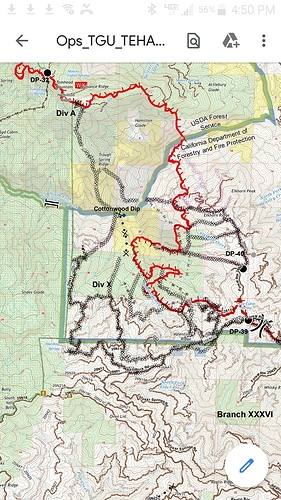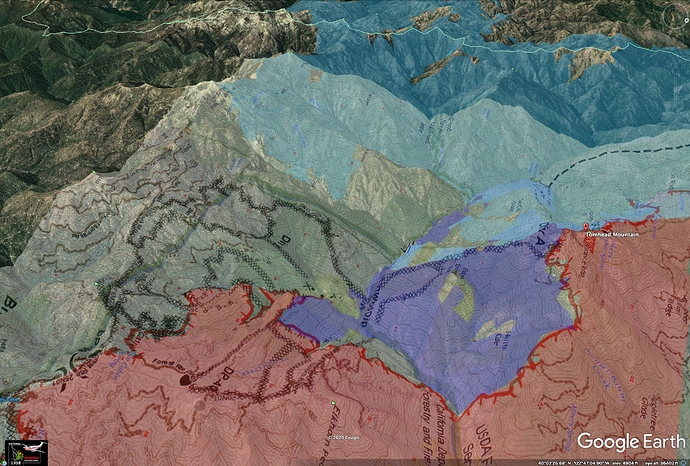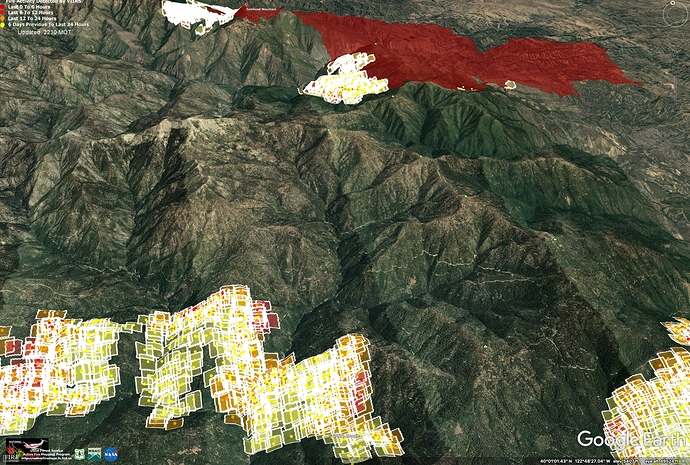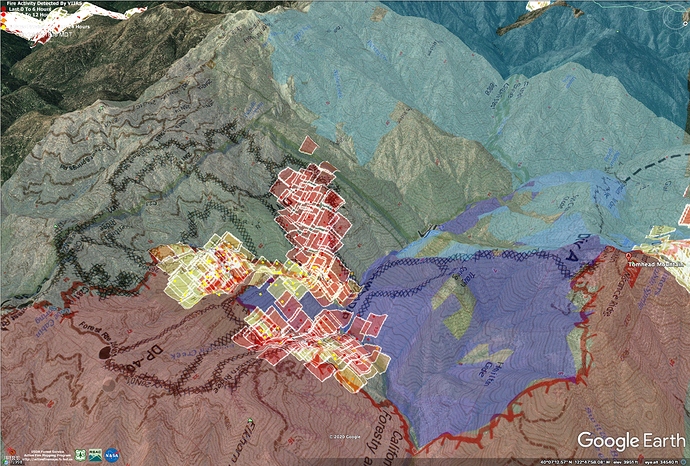Yes, heavy smoke to our south here in Chico.
Not sure why we would be working so hard to keep it out of the wilderness except for sheer doggedness. Most everything up there burned in 2008 (light blue on the image, below). The previous fires burned mainly with low or moderate severity - only 6% burned with high severity - and it’s due for another fire. Fire belongs there, and will not be denied, but we’ll risk scores of firefighter lives to execute California’s inflexible policies of full suppression. The IAP shows 22 dozers and 10 masticators on that division today, all reporting to a single drop point. They have incredibly low odds of success, and even if we manage to keep fire from entering the wilderness, what did we gain?
Who is better off if we keep fire out of here for another decade? Not the firefighters who have to fight the next fire here.
having been a faller, and on fires steep terrain can not be mitigated, while snags can be mitigated, both should be avoided if possible. If we would go in after a fire and allow the pros from Dover to go in and take out hazard trees, perhaps previous fires would be a safer area to stop fires. But I do agree that t not a tree or bush is worth a firefighters life.
Maybe Political and Public pressure…No fire is worth a life period.
Amen brother. Hopefully we can educate those you mentioned. Safety for all on this and the other fires. You certainly do your part. Congrats to you, pyro and all others
I’ve got to put out there that I’m not briefed on the particulars of the firefight on the west side of Elkhorn, and not throwing stones at the command who are stuck implementing 100 year-old failed policy. My beef is with our institutional inability to adopt 21st century ways of managing fire. And I have a feeling that we could hold this line, and still have the ground burn up from one of the other fires churning across the landscape to the south.
Elkhorn is in red, and whatever fire is to the south is well established in the next drainage over.
I agree with you. but the present command has to deal with present in place guidelines. Hopefully, they will incorporate 21 st century ways of managing fire. educate, educate…keep the faith brother
Yeah, I know they do what they can.
Well, it looks like it’s into the Wilderness now, anyhow.
Fire doesn’t read, refuses to comply with bad policy…
Hopefully they will go after it safely and allow a helpful burn
Everyone should read the big lie, it’s eye opening.http://wildlandfireleadership.blogspot.com/2016/06/the-big-lie.html?m=1
What you are advocating is robbing Peter to pay Paul. Yes if we don’t engage or go direct and let the fire get bigger then we won’t be placing ourselves in immediate harms way. But as the fire gets bigger it requires more personnel and extended commit time. With more personnel and longer commit time the probability of injury grows exponentially.
Do I want to see anyone injured or killed? Of course I don’t! I’m not saying we should ever intentionally place ourselves in harms way for little reward. Though I have also accepted that injury and deaths WILL happen. When I began this career I accepted that it was a dangerous job that could severely injury or kill me. When I was sworn in a took an oath to protect lives, property and environment. Nothing in that oath said anything about personal preservation. So my suggestion is, if people can’t get over the fact that this job is dangerous, always will be and firefighters will continue to be injured and killed no matter how safe we try to be, then it might be a good idea to look into a different profession.
The greatest way to attain safety on an incident for all stakeholder is to put the fire out plain and simple. I have said this a million times and I will continue to say it, treating an uncontrolled vegetation fire in the middle of declared fire season like a VMP is not the answer. At least it’s dangerous and at most it should be criminal under PRC 4421 and 4422.
Your trying to give a simple answer to a complex problem.
So here is my question to you pyro, what is your suggestion for achieving “21 century” suppression while mitigating risk to lives, property, the environment and the firefighter?
This conversation is specific to this place and time, not my prescription for the entire country.
Get out of the way and let the fire run into the wilderness! Don’t engage 3,000 firefighters trying to put the wilderness fire out, let it burn until it rains. Let the landowners who build or grow timber in places of extreme hazard take personal responsibility and harden their own assets. Engage firefighters at the right time and place where they have decent odds of survival and success.
I disagree putting every fire out right away is the safest solution. If we would have managed the Ranch Fire last year to run into the Red Bank, the Elkhorn Fire would not exist. Fire scars put out large fires. An immediate example for this conversation is last year’s South Fire - dark blue in map below. It was not directly attacked, and it stopped Elkhorn from running right into the wilderness several days ago. Look at the LNU Complex Fires of this year. Putting out every fire for 100 years has put us in the position we are in.
The problem is complex because we are trying to solve an impossible equation. Fire doesn’t care about policy, its math is simple - fuels, weather, and topography. We need to stop pretending we are in control, and not be afraid to admit when we are outmatched.
Ranting and raving aside, 21st century firefighting would take the FBANs and LTANS more seriously. The FBAN called out today’s spread into the wilderness in the IAP, and the Fed LTANs would tell you the odds are high all of the risky work in Div X gets eaten by large fires spreading uncontrolled to the south. We have tools to make these calls, the modeling work has already been done. Let’s connect the dots.
As an aside, the exact same time this topic started and soon moved to its own thread yesterday, there was an IWI on the MNF-August that had 1 LODD and 1 FF seriously injured. It was surreal reading this while listening to the incident unfold. So keep that respectfully in the back of the mind today and throughout the remainder of this topic (which is invaluable to read and shows there is a multitude that still has to be hashed out, sometimes in an uncomfortable way.) We are all on the same team so lets make sure this remains civil and educational…(not saying it hasn’t, just can be an edgy topic.)
Incidentally the IWI occurred on this exact piece of fire from the south, running north towards Elkhorn Div X. And nearly every LCES element in place yesterday that failed, is still in place today on that Division, so, Watch Out(?)
What is the distance to between Elkhorn and Tatum/Glade ? What’s the probability they will join?
So your saying that your ideal situation would be to let everything burn so that nothing burns going forward and to just let fires burn uncontrolled in the wilderness all summer?
Fire maybe simple math but injuries are simple statistics. The more personnel assign and the longer the assignment the greater your probability of injury becomes.
You also need to remember that different agencies have different priorities. CAL FIRE is a fire suppression agency tasked with protecting private tax paying citizens property. The Forest Service is a land management agency that is tasked with managing public lands. Very different priorities and very different strategies.
At the end of the day CAL FIRE will continue to suppress 95% of all fires at 10 acres or less. As this is the best way to protect life, property and environment.
If you disagree, please show me the facts to have to support that letting fires burn saves lives, property and environment.
Here are some facts for you though. South canyon fire, began 7/2/94, crews didn’t engage until 7/5/20. Next day 7/6/94 14 firefighter are killed in a blow up. Yarnell Hill fire began 6/28/13 crews didn’t seriously engage until 7/30/13. Same day 19 firefighter are killed in a blow up. There are many more just like these, need I go on?
I think a lot of nuance is getting missed in the dialog. Don’t miss the nuance in between “this place and time” and “let everything burn…uncontrolled…all summer.”
We have had this argument before. I’m not talking about letting IA fires burn, I’m talking about how to manage a fire that is already over 40,000 acres, and moving into very difficult ground where we will be unlikely to pick it up until it rains.
I hear your point about long campaign fires increasing exposure to everyone involved. It is valid. I don’t disagree. I’ve been involved with management of over 200 major incidents, and many, many of them had fatalities or serious injuries caused just by having a lot of people in harm’s way for a long time.
But some of these injuries occurred because we adopted aggressive tactics with low probabilities of success, or where the risk wasn’t commensurate with assets threatened, for example flying crews into remote ridges in the Trinity Alps to put out a fire that really wasn’t hurting anything or threatening the rest of the world (Iron 44). That’s what triggered this thread, a feeling of having been here before, and of knowing we were likely to hurt people as part of a losing battle.
The 2019 South Fire is right in the middle of this story. Letting that fire spread out to logical boundaries last year had an immediate benefit of protecting firefighters from working in a 10-year-old snag patch, and a secondary benefit of cleaning up heavy dead and down fuels from the 2008 fires. Having the big patch of reduced fuels during the current 2020 fire freed up resources to work on other things.
The sad fact of the matter is, there are no guarantees in fire management. What may progress into a Wilderness area for a week, may have a wind shift, and come roaring out of the forest into urban interface in the matter of a day. Not likely, but possible. Fire has been known to travel miles in a day and has a vengeance when it comes out under those circumstances. All managing and firefighting is so involved with unpredictable variables that they will probably always be risks. Whether it is a wind shear affecting an aircraft or a sudden fire devil that goes the wrong way.
Yes, so true. What if we had let a low intensity fire creep around for a few weeks in the Feather River Canyon in 2018 and had it turn into the Camp Fire?
I’m bringing up this topic for this particular fire because it truly is burning in one of the most remote areas of the State, with very little to harm for hundreds of thousands of acres. I don’t advocate letting fires burn freely outside of some really explicit geography. Nobody should assume I’m talking about this being a general strategy for the whole State.
In my 30 plus years with CDF/Calfire, can’t tell you how many times I pulled up to a fire and said " this fires doing a great VMP burn to bad we can’t burn it to the next ridge". Early season type fire when we still have little fuel moisture in the fuels. And late season fire before it greens up to much and fuels become to water bound. We have the tools I believe in weather forecasting and great fuels people in both USFS and Cal Fire. Both agencies use to do a fair amount of burning. But Politics and Public Pressure again played a big part in not VMP burning as we once did. Like LACoBC stated we need to educate both sides of the isle…My heart still aches for the South Canyon and Yarnell crew it’s just heart breaking. I’m not here for argument but so many other factors come into play with those.
The idea that we are going to burn our forest land into a pre Columbian state is nonsense. Pyro keeps saying the USFS is trying to work with a 100 year old policy. Not true. The USFS went from the 10 O’Clock control rule to “Fire Management” in the mid 1980’s. The Agency shifted from a Multiple Use Agency to a quasi preservation Agency about the same time…Forests went from a "Land of Many Uses’, to Preserving the land for Others. When it is convenient for them they are Land Managers, other times they demand to be recognized as firemen. The Forest Service is at this time an Agency looking for a mission. They should let the NPS be the preservation agency and return to multiple use. Many of our Wilderness areas are simply lines drawn on a map.
The Agency is working without a plan.





